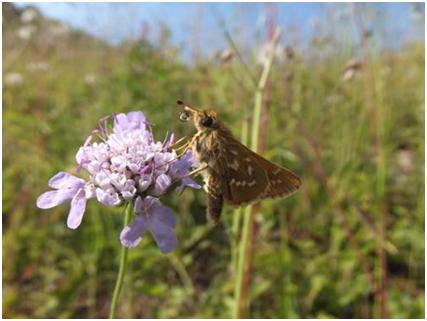On Tuesday 30th April volunteers were out and about for Spring Tour. This gave volunteers an opportunity to see the results of their winter coppicing work at Ruffett and Bigwood, and we were also lucky enough to visit some of the UK’s prime chalk grassland habitats: Betchworth Quarry, Brockham Limeworks and Denbies Hillside. Brockham Lime Works & Betchworth Quarry are part of the North Downs, a ridge of chalk hills that stretch from Surrey to Kent, and are managed by Surrey Wildlife Trust. They were once the site of a thriving industry that extracted chalk from the quarry to create quick-lime for use in mortar and fertilizers. This industry was abandoned in 1936, however, and nature was able to take over. As a result the quarry and lime works are now home to a rich variety of chalk grassland species such as rock rose, vipers bugloss and several species of orchid. One of the rarer species you can find here is the Silver-spotted Skipper butterfly (Hesperia comma).
The Silver-spotted Skipper is a national rarity that is now confined to small distinct colonies across chalk grassland sites in the south of England. The Silver-spotted Skipper is a warm-loving butterfly, and will only take flight when the temperature rises above 20°C. They love to bask on the warmest patch of ground they can find, which is usually a sheltered, south-facing, bare slope. Betchworth Quarry has many exposed chalk faces, which reflect the sun light into the quarry and create a warmer ambient temperature than the surrounding hillsides. This makes it the perfect habitat for this warm-loving butterfly. The rocky cliffs characteristic along the North Downs actually provide a variety of aspects (the direction in which the hill slope faces), which influence the temperature of the cliff face. If you have many different aspects, then there will be several different temperatures present on just one cliff face (microclimates). Warmer microclimates attract certain plants and insects to the area, such as the chalk grassland butterflies: the Adonis Blue (Polyommatus bellargus) and Chalkhill Blue (Polyommatus coridon), both of which are found at Denbies Hillside.

Chalkhill Blue (Polyommatus coridon) Photo: © Phil and Ann Farrer
These rocky cliffs and steep slopes are a marked contrast to the flat chalk grassland sites we have in Sutton. Sutton contains about 170 hectares of chalk grassland, including golf courses. In London, chalk grassland is restricted to the southern edges in Sutton, Croydon and Bromley on the North Downs. The largest chalk grassland site in the borough is Roundshaw Downs but most of the others are much smaller in size. Despite lacking the variety of unique microclimates present on the North Downs Sutton’s chalk grasslands still support many rare and protected species, such as the nationally scarce Greater Yellow-rattle (Rhinanthus angustifolius) and the rare Small Blue (Cupido minimus) and skylark. It was great to see a variety of chalk grassland species that we don’t usually see in Sutton, because of the different topography and variety of aspects found on the North Downs. By visiting these wonderful prime chalk grassland sites, it’s not hard to believe that this habitat contains some of the most diverse plant communities in the UK.
Eleanor Kirby-Green SNCV Biodiversity Assistant








